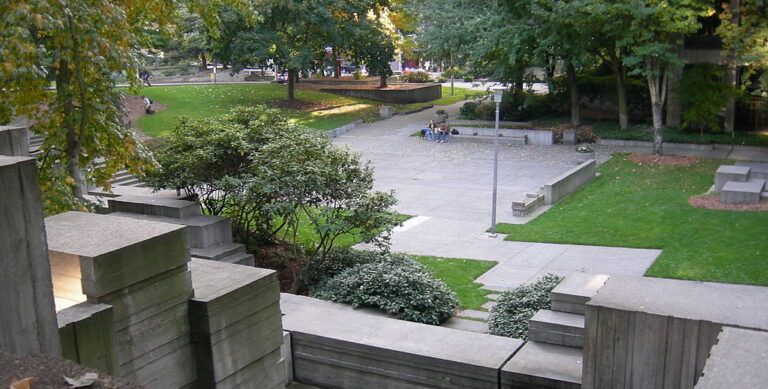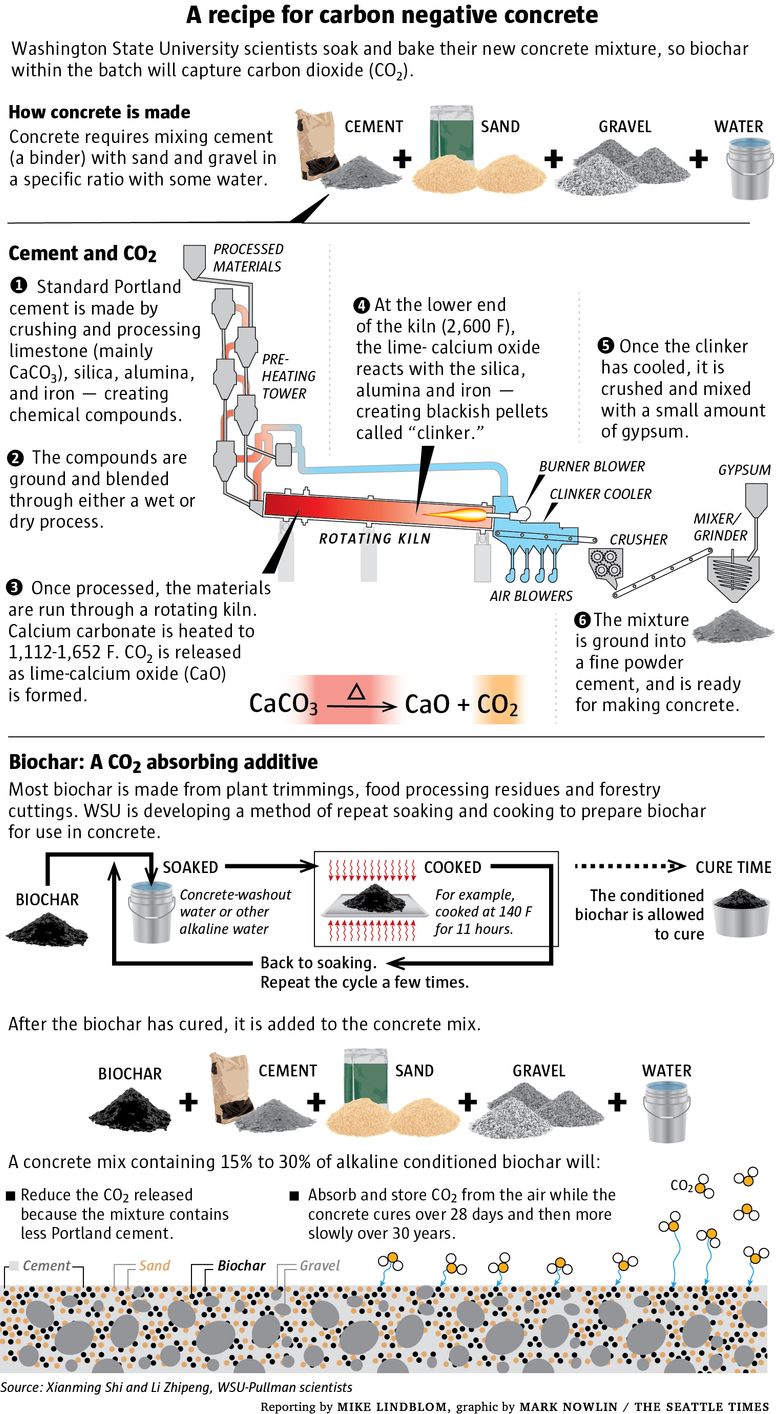Published on January 19, 2024

From The Seattle Times
PULLMAN — From a onetime speakeasy in North Seattle to a modern lab in the Palouse, inventors are testing recipes that make concrete less lethal to Earth’s climate.
Most people understand that the world’s 1.4 billion fossil-fueled cars and trucks spew carbon dioxide, trapping heat in the atmosphere. We’re not so aware of the environmental toll of concrete in highway pavement, or within dams, pipes, towers, stadiums, garages and transit stations.
Concrete generates 8% of manmade carbon emissions. They’re produced mainly by chemical reactions in the worldwide production of Portland cement, a dry compound containing limestone. Cement binds with water, sand and rock to form concrete.
“We are not going to solve the overall global warming problem without solving the concrete problem, and we do not have very long,” said Phil Northcott, founder of C Change Labs in Coquitlam, B.C., which models carbon dioxide emissions to help builders choose cleaner materials and methods.
Fortunately, most of the technology and ingenuity already exists, he said. What’s missing is the business case for action.
Washington could become a proving ground, because of local products, continued building construction, and the state’s voracious appetite for concrete.
Low-CO2 products are appearing first in surface roads, sidewalks and buildings. Potentially, they could be used someday in bridge spans and columns that must withstand earthquakes. Sound Transit is embarking on the nation’s largest rail transit expansion, requiring up to 62 miles of concrete beams, trackbeds and tunnels, as well as concrete parking structures.
Already, some concoctions are getting a tryout.
Cream-colored walls at the Seattle Storm’s future practice facility in Interbay contain granulated slag from steel-mill furnaces, as do the landmark Amazon Spheres downtown, as a means to use less Portland cement. Natural minerals bind basement foundations at a 112-year-old brick building near Green Lake. A Microsoft data center in Central Washington contains algae as a substitute for limestone.
“I’d argue that Seattle is the most innovative concrete market that there is, and there’s some pretty cool stuff going on,” Rob Shogren, regional technical director for Lafarge’s giant cement works in South Seattle, told an industry forum. Lafarge operates a laboratory here and produces reduced-carbon mixtures.
Washington State University scientists even say they’ve invented a “carbon-negative” cement in which fine-grain black biochar, made from plants, captures carbon from the air.
Washington accounts for about two-thousandths of global greenhouse gas pollution.
Time is critical.
“Life on planet Earth is under siege. We are now in an uncharted territory,” warned a recent report, co-authored by Oregon State University scientists. Earth’s atmosphere has heated 2 degrees Fahrenheit since the Industrial Revolution, on course to surpass 2.7 degrees, reported the Intergovernmental Panel on Climate Change.
Concrete jungle
Since the early 1800s, modern builders have relied mainly on Portland cement, named after a stony isle in the English Channel, that inventors found to be stronger than brick mortar for many purposes. Annual cement production totals 4.2 billion tons, or nearly 1,000 pounds per human.
Limestone (calcium carbonate) and clay are crushed and heated to 2,700 degrees. A chemical reaction releases carbon dioxide, while more emissions result from firing the kiln with natural gas, oil or coal. This combustion produces gray, calcium-rich pebbles called clinker, ground alongside gypsum into powdery cement.
Can something cleaner do the job?
These days, inventors are thinking about the Roman Empire, which built the Colosseum, domed Pantheon and dock pilings using volcanic pumices called pozzolans, that harden in H2O without releasing CO2.
New natural and synthetic pozzolans are competing for attention, and research grants. A common pozzolan this century is fly ash, a byproduct of coal combustion, but supplies are dwindling in North America.
University of Washington scientist Brandon Lou has been mixing and crushing small cubes of zeolite concrete in the UW Materials Science & Engineering lab. Magnified 7,000 times, the cross-sections reveal a molecular garden, where crystals of calcium hydroxide grow into what looks like six-sided armor plates.
A zeolite mix with C-Crete was poured last fall to build a storage yard at Hubbard’s Corner, and Western Interlock manufactured 3,800 zeolite paving stones in Oregon, for uses such as patios.
Northwest experts say the main hurdles are supply chains and startup costs to make new cements in industrial-size quantities. And the risk-aversion of civil engineers, especially in transportation, to be first adopters.
“What we are finding is, that nobody truly cares about lower-CO2 concrete or concrete products, unless it is cheaper,” Uhm added.
Seattle nonprofit Building Transparency provides a free calculator, co-sponsored by major employers, to help builders choose cleaner materials and methods.
Storm of innovation
Some Seattle landmarks already contain low-carbon blends.
Slag-filled concrete is so bright, at the Storm’s site in Interbay, the team won’t apply paint. “When you get a sunny day, this wall is blinding. You’ve got to put sunglasses on,” said Sarah Carlson, project manager for Sellen construction, watching more truckloads arrive from Stoneway Concrete.
As long ago as 2013, Stoneway poured a cleaner concrete, containing a 50% slag cement, in the giant Highway 99 tunnel south portal, said Greg McKinnon, general manager of Stoneway.
Then the Amazon Spheres in 2018 averted 80% of CO2 emissions, touted worldwide by Swiss giant Holcim, which supplied the concrete from its Lafarge plant on the Duwamish River.
The Elliott Bay seawall replaced three-fourths of the usual Portland cement with slag, fly ash and microsilica, McKinnon said.
The Seattle Aquarium expansion and new Alaskan Way — “practically everything you see on the waterfront,” he said — contain Type 1L, which replaces some clinker with straight limestone powder, lowering emissions one-quarter. It’s accepted by 48 states, and commonly used by the Washington State Department of Transportation, he said.
Many inventors large and small hope to accomplish more than a one-fourth carbon reduction.
Oregon startup Solid Carbon is redirecting processed sewage, to form a biocharlike ingredient replacing sand. The concrete does contain Portland cement, but biosolids compensate by absorbing CO2. That strategy, to capture carbon in admixtures, differs from WSU’s quest to imbue biochar with binding properties.
Solid Carbon supplied three Habitat for Humanity houses in Gig Harbor, and Remy Wines in Dayton, Ore., among others. “We’re going 100 miles an hour, and if we had more material, we’d be selling it,” CEO John Mead said.
Worldwide, the most promising product is limestone-calcined clay cement, said Jordan Palmeri, senior researcher for UW’s Carbon Leadership Forum. A soft white clay called kaolin, traditional in ceramics and paper, is cooked to 1,400 degrees. The reddish residue binds to powdered limestone, so makers can replace half the carbon-emitting clinker.
That benefit, along with non-fossil fuels, leaner concrete structures and reuse of buildings, could slash emissions 75%, Swiss scientist Karen Scrivener told the Rocky Mountain Institute, a clean-energy think tank.
“What’s important is to act now. It’s no good to wait for some miracle solution that comes along in 50 to 100 years time, because by that time, we’ve already got a lot of global warming,” said Scrivener, who is leading international adoption of calcined-clay concretes, especially by India.
To succeed, low-carbon concrete technologies must be doable on a global scale, said Northcott, the expert from C Change in British Columbia. The best strategy is to rebuild cement-factory kilns, to pipe their carbon dioxide waste directly into the ground, he said. It’s doable in regions near oil wells, but not Puget Sound, he said.
Natural pozzolans, mined in bulk, also show the potential to create widespread environmental improvements, he said. Northcott is less bullish on ingredients like biochar, which require extra production steps, and may be limited to niche uses.
“If the right technologies are deployed and scaled, concrete emissions could fall by a factor of 10,” he said. New inventions do create a risk of “greenwashing,” where advocates push wasteful projects or ineffective materials, he said. “There are many ways to hose ourselves.”
UW’s Palmeri emphasized: “If we didn’t have as much demand for concrete, we would also be solving the problem, more effectively.”
